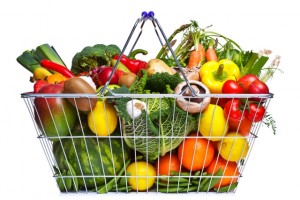Did you know that some healthy foods you may be eating on a regular basis could actually be doing you more harm than good? Most of the time, the foods themselves are healthy and can help you lose weight, but how they are grown and what is found in and on them will surprise you! This blog post will explain how eating clean doesn’t just mean eating healthy foods. It also involves knowing how your food is grown and how it gets to your plate.
Many produce items grown on large farms these days is absolutely drenched in pesticides, antibiotics, and other substances that allow the food to grow big and beautiful but can be extremely harmful to human bodies. Buying organic is the easiest way to avoid these chemicals, but awareness can also help when eating clean. That’s why we’ve brought you some resources to teach you which foods are safe and which foods you should be avoiding in order to lose weight.
First of all, check out the extremely helpful website- www.whatsonmyfood.org. It gives great information about potential contaminants on your food and shows you what you might be inadvertently putting into your body. You can also look up clean eating recipes online to find simple ways to eat the best foods and lose weight the healthy way.
It might also be worth signing up for a weight management program that directs you towards the right foods. With GxSlim, for example, we’ll make sure that you are eating clean to lose weight with only the healthiest foods that your body responds well to. We can even discuss clean eating recipes with you. Your genes can determine which foods are good for you, so make sure that you are using a weight management program like GxSlim that incorporates your DNA into your diet!
Next, we want to point you to the Environmental Working Group’s list of the “Dirty Dozen” and the “Clean Fifteen.” The Dirty Dozen is a list of twelve produce items with the highest pesticide loads, and the Clean Fifteen lists the produce that is least likely to contain pesticides. Check out this summary of the 2015 lists from the EWG website below:
“Highlights of Dirty Dozen™ 2015
EWG singles out produce with the highest pesticide loads for its Dirty Dozen™ list. This year, it is comprised of apples, peaches, nectarines, strawberries, grapes, celery, spinach, sweet bell peppers, cucumbers, cherry tomatoes, imported snap peas and potatoes.
Each of these foods tested positive a number of different pesticide residues and showed higher concentrations of pesticides than other produce items.
Key findings:
- 99 percent of apple samples, 98 percent of peaches, and 97 percent of nectarines tested positive for at least one pesticide residue.
- The average potato had more pesticides by weight than any other produce.
- A single grape sample and a sweet bell pepper sample contained 15 pesticides.
- Single samples of cherry tomatoes, nectarines, peaches, imported snap peas and strawberries showed 13 different pesticides apiece.
The Clean Fifteen™
EWG’s Clean Fifteen™ list of produce least likely to hold pesticide residues consists of avocados, sweet corn, pineapples, cabbage, frozen sweet peas, onions, asparagus, mangoes, papayas, kiwis, eggplant, grapefruit, cantaloupe, cauliflower and sweet potatoes. Relatively few pesticides were detected on these foods, and tests found low total concentrations of pesticides on them.
Key findings:
- Avocados were the cleanest: only 1 percent of avocado samples showed any detectable pesticides.
- Some 89 percent of pineapples, 82 percent of kiwi, 80 percent of papayas, 88 percent of mango and 61 percent of cantaloupe had no residues.
- No single fruit sample from the Clean Fifteen™ tested positive for more than 4 types of pesticides.
- Multiple pesticide residues are extremely rare on Clean Fifteen™ vegetables. Only 5.5 percent of Clean Fifteen samples had two or more pesticides.
Not sure how to actually incorporate this information into your diet? Never fear! You can look online for clean eating recipes. But also, if you purchase GxSlim, our Genetic Direction telehealth coaches are always available to discuss diet plans that incorporate eating clean into your life and help you lose weight. We tailor your diet plan to your DNA, so you are not only eating foods that your body responds really well to, but you’re also eating clean!
PS. To learn more about the invisible toxins in your food, listen to this recording from last Saturday’s Train Station Fitness Show with George DiGianni:


